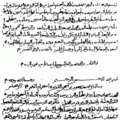Cryptanalysis facts for kids
Cryptanalysis is the exciting study of how to figure out secret messages. It's like being a detective for hidden information! The word comes from two Greek words: kryptós, meaning "hidden," and analýein, meaning "to untie" or "to loosen."
In simpler words, cryptanalysis is all about codebreaking or cracking the code. It means finding the secret meaning of a message even if you don't have the special key or password needed to unlock it. This "secret key" is like the missing piece of a puzzle that lets you read the hidden message.
People have been creating and breaking codes for hundreds of years. In the 1930s, clever inventors started building special machines to help with these complex calculations.
Contents
What is Cryptanalysis?
Cryptanalysis is the science of looking at encrypted (secret) messages and trying to understand them. It's like trying to read a diary written in a secret language without knowing the alphabet. Codebreakers use different methods to find patterns or weaknesses in the way a message was made secret.
How Codebreaking Works
Imagine a secret message that looks like a jumble of letters. A cryptanalyst tries to find the rules that turned the original message into the jumbled one. They might look for:
- Common letters or words.
- Repeated patterns.
- How often certain letters appear.
- Mistakes made by the person who created the code.
By finding these clues, they can slowly piece together the secret key. Once they have the key, they can read the entire message!
History of Codebreaking
Codebreaking has played a huge role in history, especially during wars. Knowing what your enemies are planning can change the outcome of battles and even entire wars.
Early Codebreakers
One of the earliest known codebreakers was Al-Kindi, a brilliant Arab scholar from the 9th century. He wrote a book about how to break codes using a method called frequency analysis. This method looks at how often each letter appears in a language. For example, in English, the letter 'E' is used much more often than 'Z'.
Codebreaking in World Wars
During World War I and World War II, codebreaking became incredibly important.
- In World War I, the British famously broke the Zimmermann Telegram. This secret message from Germany to Mexico helped convince the United States to join the war.
- During World War II, powerful code-breaking machines were invented. The Colossus computer was one such machine, used by the British at Bletchley Park. It helped break the complex codes used by the German Enigma machine.
- The Bombe machine, also used at Bletchley Park, was another key tool. It helped figure out the daily settings of the Enigma machines.
- In the Battle of Midway during World War II, American codebreakers cracked the Japanese naval code. This allowed the Americans to know exactly where the Japanese fleet was going and what their plans were. This secret knowledge helped the United States win a very important battle.
Modern Cryptanalysis
After World War II, during the Cold War and beyond, computers became the main tools for cryptanalysis. Today, with very powerful computers, codes are much harder to break. Modern encryption methods are designed to be so strong that it would take a supercomputer billions of years to guess the key. However, cryptanalysts are always looking for new ways to test and potentially break even the strongest codes.
Related pages
Images for kids
-
The first page of Al-Kindi's 9th-century book, Manuscript on Deciphering Cryptographic Messages.
-
The Zimmermann Telegram after it was secretly decoded.
-
A replica of the Bombe machine at Bletchley Park. It copied how several Enigma machines worked together, with each spinning drum acting like an Enigma rotor.
See also
 In Spanish: Criptoanálisis para niños
In Spanish: Criptoanálisis para niños





